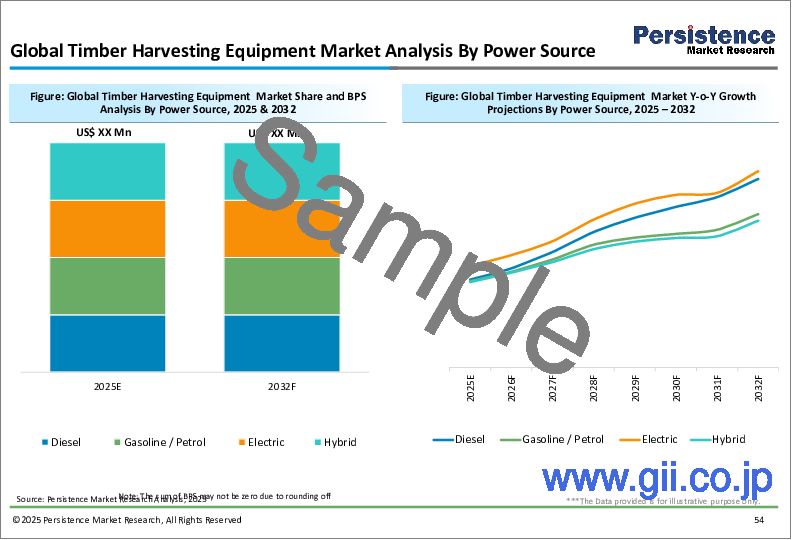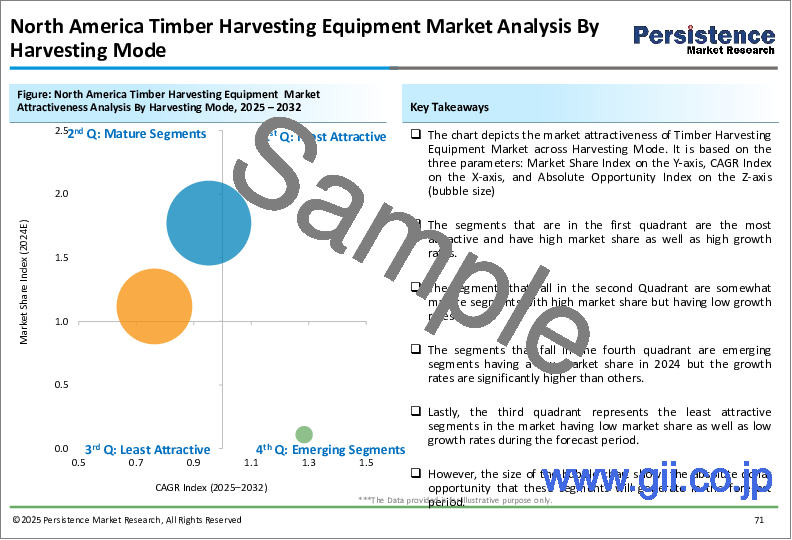|
|
市場調査レポート
商品コード
1607944
木材伐出機械の世界市場:産業分析、規模、シェア、成長、動向、予測(2024年~2031年)Timber Harvesting Equipment Market: Global Industry Analysis, Size, Share, Growth, Trends, and Forecast, 2024-2031 |
||||||
カスタマイズ可能
|
|||||||
| 木材伐出機械の世界市場:産業分析、規模、シェア、成長、動向、予測(2024年~2031年) |
|
出版日: 2024年12月03日
発行: Persistence Market Research
ページ情報: 英文 209 Pages
納期: 2~5営業日
|
全表示
- 概要
- 目次
重要考察
- 木材伐出機械の市場規模:183億5,570万米ドル(2024年)
- 予測される市場金額:221億6,090万米ドル(2031年)
- 世界市場の成長率:4.4%(2024年~2031年のCAGR)
木材伐出機械市場 - レポート範囲
木材伐出機械とは、商業目的での森林の木の切断、伐採、加工に使用されるさまざまな機械を指します。これには、チェンソー、ハーベスター、フェラーバンチャー、その他の木材伐採のさまざまな段階を処理するために設計された機械が含まれます。市場の促進要因は、木材需要の増加、林業における機械化の進行、機械の性能と効率における技術的進歩です。林業部門では持続可能性が重視されるようになり、環境に対する影響を最小限に抑える先進の伐採機械の採用も増加しています。
市場成長の促進要因
木材伐出機械市場の成長は、建設、家具、紙産業における木材製品の需要の増加など、複数の要因によって促進されています。林業における機械化は、作業効率と生産性を高め、人件費を削減し、木材伐出作業の安全性を高めるのに役立ちます。さらに、自律型機械、環境にやさしい設計、燃料効率の向上などの技術革新が市場拡大を後押ししています。持続可能な林業の実践を促進する政府の規制も、先進の効率的な機械の需要に影響を与えています。
市場抑制要因
前向きな成長見通しにもかかわらず、木材伐出機械市場は、先進の機械やメンテナンスの高いコストなどの課題に直面しています。資金調達オプションへのアクセスが限られていることや、機械の操作が複雑であることから、特に小規模で資本力の乏しい林業者では、採用が制限される可能性があります。さらに、森林伐採や土地の劣化に関連する環境への懸念から、規制が強化され、市場成長に影響を及ぼす可能性もあります。先進の機械を操作する熟練労働者の確保も、市場の将来性を制限する要因です。
市場機会
木材伐出機械市場は、特にロボット工学、自動化、GPS追跡などの新技術の採用を通じて、複数の成長機会を示しています。これらの技術革新は、木材伐採作業の精度、効率、安全性を向上させることができ、業者にとって魅力的なものとなっています。さらに、持続可能な林業を目指す動向の高まりは、機械メーカーにとって、環境に対する影響を低減する環境にやさしい機械を開発する機会となります。林業が拡大しているアジア太平洋とラテンアメリカの新興市場は、機械メーカーにさらなる成長機会を提供しています。
当レポートでは、世界の木材伐出機械市場について調査分析し、促進要因、動向、課題、将来の機会などの詳細な分析を提供しています。
目次
第1章 エグゼクティブサマリー
第2章 市場のイントロダクション
第3章 世界の木材伐出機械市場の分析シナリオ
- 市場規模の予測
- 市場規模と前年比成長
- 絶対的収益機会
- バリューチェーン
- 価格分析
- ポーターのファイブフォース分析
- 車輪式と履帯式の比較
- 伐出方式の比較
- 運用コストの比較
- マクロ経済要因
- 予測要因
- 市場力学
- 促進要因
- 抑制要因
- 動向
第4章 世界の木材伐出機械市場の分析(2019年~2023年)と予測(2024年~2031年):製品タイプ別
- 市場規模と数量の実績の分析:製品タイプ別(2019年~2023年)
- 現在の市場規模と数量の分析:製品タイプ別(2024年~2031年)
- チェーンソー
- ハーベスター
- フェラーバンチャー
- フォワーダー
- スキッダー
- 市場の魅力分析:製品タイプ別
第5章 世界の木材伐出機械市場の分析(2019年~2023年)と予測(2024年~2031年):伐出方式別
- 市場規模と数量の実績の分析:伐出方式別(2019年~2023年)
- 現在の市場規模と数量の分析:伐出方式別(2024年~2031年)
- 全木集材
- 短幹集材
- 全幹集材
- 市場の魅力分析:伐出方式別
第6章 世界の木材伐出機械市場の分析(2019年~2023年)と予測(2024年~2031年):地域別
- 市場規模と数量の実績の分析:地域別(2019年~2023年)
- 現在の市場規模と数量の分析:地域別(2024年~2031年)
- アジア太平洋
- 北米
- ラテンアメリカ
- 欧州
- 中東・アフリカ
- 市場の魅力分析:地域別
第7章 アジア太平洋の木材伐出機械市場の分析(2019年~2023年)と予測(2024年~2031年)
- 市場規模と数量の実績の分析:市場分類別(2019年~2023年)
- 国別
- 製品タイプ別
- 伐出方式別
- 現在の市場規模と数量の分析:国別(2024年~2031年)
- 中国
- インド
- 日本
- ASEAN
- オーストラリア
- その他のアジア太平洋
- 現在の市場規模と数量の分析:伐出方式別(2024年~2031年)
- 全木集材
- 短幹集材
- 全幹集材
- 現在の市場規模と数量の分析:製品タイプ別(2024年~2031年)
- チェーンソー
- ハーベスター
- フェラーバンチャー
- フォワーダー
- スキッダー
- 現在の市場規模と数量の分析:伐出方式別(2024年~2031年)
- 全木集材
- 短幹集材
- 全幹集材
- 促進要因と抑制要因:影響の分析
- 市場の魅力分析
- 国別
- 製品タイプ別
- 伐出方式別
- 市場参入企業
第8章 北米の木材伐出機械市場の分析(2019年~2023年)と予測(2024年~2031年)
- 市場規模と数量の実績の分析:市場分類別(2019年~2023年)
- 国別
- 製品タイプ別
- 伐出方式別
- 現在の市場規模と数量の分析:国別(2024年~2031年)
- 米国
- カナダ
- 現在の市場規模と数量の分析:製品タイプ別(2024年~2031年)
- チェーンソー
- ハーベスター
- フェラーバンチャー
- フォワーダー
- スキッダー
- 現在の市場規模と数量の分析:伐出方式別(2024年~2031年)
- 全木集材
- 短幹集材
- 全幹集材
- 促進要因と抑制要因:影響の分析
- 市場の魅力分析
- 国別
- 製品タイプ別
- 伐出方式別
- 市場参入企業
第9章 ラテンアメリカの木材伐出機械市場の分析(2019年~2023年)と予測(2024年~2031年)
- 現在の市場規模と数量の分析:市場分類別(2019年~2023年)
- 国別
- 製品タイプ別
- 伐出方式別
- 現在の市場規模と数量の分析:国別(2024年~2031年)
- ブラジル
- メキシコ
- チリ
- その他のラテンアメリカ
- 現在の市場規模と数量の分析:製品タイプ別(2024年~2031年)
- チェーンソー
- ハーベスター
- フェラーバンチャー
- フォワーダー
- スキッダー
- 現在の市場規模と数量の分析:伐出方式別(2024年~2031年)
- 全木集材
- 短幹集材
- 全幹集材
- 促進要因と抑制要因:影響の分析
- 市場の魅力分析
- 国別
- 製品タイプ別
- 伐出方式別
- 市場参入企業
第10章 欧州の木材伐出機械市場の分析(2019年~2023年)と予測(2024年~2031年)
- 現在の市場規模と数量の分析:市場分類別(2019年~2023年)
- 国別
- 製品タイプ別
- 伐出方式別
- 現在の市場規模と数量の分析:国別(2024年~2031年)
- ロシア
- スウェーデン
- フィンランド
- ドイツ
- フランス
- イタリア
- スペイン
- 英国
- ベネルクス
- その他の欧州
- 現在の市場規模と数量の分析:製品タイプ別(2024年~2031年)
- チェーンソー
- ハーベスター
- フェラーバンチャー
- フォワーダー
- スキッダー
- 現在の市場規模と数量の分析:伐出方式別(2024年~2031年)
- 全木集材
- 短幹集材
- 全幹集材
- 促進要因と抑制要因:影響の分析
- 市場の魅力分析
- 国別
- 製品タイプ別
- 伐出方式別
- 市場参入企業
第11章 中東・アフリカの木材伐出機械市場の分析(2019年~2023年)と予測(2024年~2031年)
- 市場規模と数量の実績:市場分類別(2019年~2023年)
- 国別
- 製品タイプ別
- 伐出方式別
- 現在の市場規模と数量の分析:国別(2024年~2031年)
- トルコ
- ナイジェリア
- コンゴ
- エチオピア
- 南アフリカ
- その他の中東・アフリカ
- 現在の市場規模と数量の分析:製品タイプ別(2024年~2031年)
- チェーンソー
- ハーベスター
- フェラーバンチャー
- フォワーダー
- スキッダー
- 現在の市場規模と数量の分析:伐出方式別(2024年~2031年)
- 全木集材
- 短幹集材
- 全幹集材
- 促進要因と抑制要因:影響の分析
- 市場の魅力分析
- 国別
- 製品タイプ別
- 伐出方式別
- 市場参入企業
第12章 競合情勢
- 市場プレゼンス(強度マップ)
- 競合強度マップ:市場分類別
- 競合ダッシュボード
- 企業プロファイル(詳細 - 概要、財務、戦略、近年の動向)
- Deere & Company
- Komatsu Ltd.
- Ponsse Oyj
- Caterpillar Inc.
- Tigercat International Inc.
- Logset Oy
- Eco Log Sweden AB
- Rottne Industri AB
- Husqvarna AB
- Andreas Stihl AG & Company KG
- Stanley Black & Decker, Inc.
- Hitachi Ltd.
- Kesla Oyj
- Barko Hydraulics L.L.C.
- Bell Equipment Ltd.
- Volvo AB
- Sampo-Rosenlew Oy
- Echo Inc.
第13章 前提条件と頭字語
第14章 調査手法
Persistence Market Research has recently released a comprehensive report on the global Timber Harvesting Equipment Market, providing an in-depth analysis of key market dynamics, including driving forces, emerging trends, opportunities, and challenges. This report offers a detailed understanding of the market landscape, helping stakeholders make well-informed decisions.
Key Insights:
- Timber Harvesting Equipment Market Size (2024E): USD 18,355.7 Mn
- Projected Market Value (2031F): USD 22,160.9 Mn
- Global Market Growth Rate (CAGR 2024 to 2031): 4.4%
Timber Harvesting Equipment Market - Report Scope:
Timber harvesting equipment refers to a range of machinery used for the cutting, felling, and processing of trees in forests for commercial purposes. This includes chainsaws, harvesters, feller bunchers, and other machinery designed to handle various stages of timber harvesting. The market is driven by growing demand for timber, increased mechanization in the forestry industry, and technological advancements in equipment performance and efficiency. As sustainability becomes more important in the forestry sector, the adoption of advanced harvesting machinery that minimizes environmental impact is also increasing.
Market Growth Drivers:
The growth of the timber harvesting equipment market is propelled by several factors, including the increasing demand for timber products in construction, furniture, and paper industries. Mechanization in forestry helps increase operational efficiency and productivity, reducing labor costs and enhancing safety in timber harvesting operations. Additionally, technological innovations such as autonomous machinery, eco-friendly designs, and improved fuel efficiency are driving market expansion. Government regulations promoting sustainable forestry practices are also influencing the demand for more advanced and efficient equipment.
Market Restraints:
Despite the positive growth outlook, the timber harvesting equipment market faces certain challenges, such as the high cost of advanced machinery and maintenance. Limited access to financing options and the complex nature of equipment operation may restrict adoption, particularly in smaller, less capitalized forestry operations. Additionally, environmental concerns related to deforestation and land degradation may lead to stricter regulations, which could impact market growth. The availability of skilled labor to operate sophisticated machinery is also a factor that could limit market potential.
Market Opportunities:
The timber harvesting equipment market presents several growth opportunities, particularly through the adoption of new technologies like robotics, automation, and GPS tracking. These innovations can improve the precision, efficiency, and safety of timber harvesting operations, making them more attractive to operators. Furthermore, the growing trend toward sustainable forestry practices presents an opportunity for equipment manufacturers to develop eco-friendly machinery that reduces environmental impact. Emerging markets in Asia Pacific and Latin America, where forestry operations are expanding, offer additional growth opportunities for equipment manufacturers.
Key Questions Answered in the Report:
- What are the main factors driving the growth of the timber harvesting equipment market?
- Which regions are witnessing the highest adoption of timber harvesting equipment?
- How are technological advancements in harvesting machinery influencing the competitive landscape?
- Who are the leading players in the timber harvesting equipment market, and what strategies are they employing to maintain their market position?
- What are the emerging trends and future outlooks for the global timber harvesting equipment market?
Competitive Intelligence and Business Strategy:
Leading players in the global timber harvesting equipment market, such as Deere & Company, Komatsu Ltd., and Ponsse Oyj, are focusing on product innovation, operational efficiency, and strategic partnerships to maintain a competitive edge. These companies are investing in the development of advanced, eco-friendly machinery and enhancing product lines with autonomous and semi-autonomous features. Partnerships with forestry operators, technology providers, and government agencies play a critical role in market penetration and growth. Sustainability initiatives, cost optimization, and diversification of product offerings are key strategies that companies are adopting to capture market share.
Key Companies Profiled:
- Deere & Company
- Komatsu Ltd.
- Ponsse Oyj
- Caterpillar Inc.
- Tigercat International Inc.
- Logset Oy
- Eco Log Sweden AB
- Rottne Industri AB
- Husqvarna AB
- Andreas Stihl AG & Company KG
- Stanley Black & Decker, Inc.
- Hitachi Ltd.
- Kesla Oyj
- Barko Hydraulics L.L.C.
- Bell Equipment Ltd.
- Volvo AB
- Sampo-Rosenlew Oy
- Echo Inc.
- Others
Timber Harvesting Equipment Market Segmentation:
By Product Type:
- Chainsaws
- Harvesters
- Wheeled Type
- Tracked Type
- Feller Bunchers
- Wheeled Type
- Tracked Type
- Forwarders
- Skidders
By Harvesting Mode:
- Full Tree
- Cut-To-Length
- Tree Length
By Region:
- Asia Pacific
- North America
- Latin America
- Europe
- Middle East & Africa
Table of Contents
1. Executive Summary
- 1.1. Market Overview
- 1.2. Market Analysis
- 1.3. PMR Analysis and Recommendations
- 1.4. Wheel of Fortune
2. Market Introduction
- 2.1. Market Definition
- 2.2. Market Taxonomy
3. Global Timber Harvesting Equipment Market Analysis Scenario
- 3.1. Introduction
- 3.1.1. Market Volume Projections
- 3.1.2. Market Size and Y-o-Y Growth
- 3.1.3. Absolute $ Opportunity
- 3.2. Value Chain
- 3.3. Pricing Analysis
- 3.4. Porter's Five Forces Analysis
- 3.5. Wheeled vs Tracked Comparison
- 3.6. Harvesting Mode Comparison
- 3.7. Operation Cost Comparison
- 3.8. Macro-economic Factors
- 3.9. Forecast Factors
- 3.10. Market Dynamics
- 3.10.1. Drivers
- 3.10.2. Restraints
- 3.10.3. Trends
4. Global Timber Harvesting Equipment Market Analysis 2019-2023 and Forecast 2024-2031 By Product Type
- 4.1. Introduction
- 4.2. Historical Market Size (US$ Mn ) and Volume (Units) Analysis By Product Type, 2019-2023
- 4.3. Current Market Size (US$ Mn ) and Volume (Units) Analysis By Product Type, 2024-2031
- 4.3.1. Chainsaws
- 4.3.2. Harvesters
- 4.3.2.1. Wheeled Type
- 4.3.2.2. Tracked Type
- 4.3.3. Feller Bunchers
- 4.3.3.1. Wheeled Type
- 4.3.3.2. Tracked Type
- 4.3.4. Forwarders
- 4.3.5. Skidders
- 4.4. Market Attractiveness Analysis By Product Type
5. Global Timber Harvesting Equipment Market Analysis 2019-2023 and Forecast 2024-2031 By Harvesting Mode
- 5.1. Introduction
- 5.2. Historical Market Size (US$ Mn ) and Volume (Units) Analysis By Harvesting Mode, 2019-2023
- 5.3. Current Market Size (US$ Mn ) and Volume (Units) Analysis By Harvesting Mode, 2024-2031
- 5.3.1. Full Tree
- 5.3.2. Cut-To-Length
- 5.3.3. Tree Length
- 5.4. Market Attractiveness Analysis By Harvesting Mode
6. Global Timber Harvesting Equipment Market Analysis 2019-2023 and Forecast 2024-2031 By Region
- 6.1. Introduction / Key Findings
- 6.2. Historical Market Size (US$ Mn ) and Volume (Units) Analysis By Region, 2019-2023
- 6.3. Current Market Size (US$ Mn ) and Volume (Units) Analysis By Region, 2024-2031
- 6.3.1. Asia Pacific
- 6.3.2. North America
- 6.3.3. Latin America
- 6.3.4. Europe
- 6.3.5. Middle East & Africa
- 6.4. Market Attractiveness Analysis By Region
7. Asia Pacific Timber Harvesting Equipment Market Analysis 2019-2023 and Forecast 2024-2031
- 7.1. Introduction
- 7.2. Historical Market Size (US$ Mn ) and Volume (Units) Analysis By Market Taxonomy, 2019-2023
- 7.2.1. By Country
- 7.2.2. By Product Type
- 7.2.3. By Harvesting Mode
- 7.3. Current Market Size (US$ Mn ) and Volume (Units) Analysis By Country, 2024-2031
- 7.3.1. China
- 7.3.2. India
- 7.3.3. Japan
- 7.3.4. ASEAN
- 7.3.5. ANZ
- 7.3.6. Rest of Asia Pacific
- 7.4. Current Market Size (US$ Mn ) and Volume (Units) Analysis By Manufacturing Process, 2024-2031
- 7.4.1. Full Tree
- 7.4.2. Cut-To-Length
- 7.4.3. Tree Length
- 7.5. Current Market Size (US$ Mn ) and Volume (Units) Analysis By Product Type, 2024-2031
- 7.5.1. Chainsaws
- 7.5.2. Harvesters
- 7.5.2.1. Wheeled Type
- 7.5.2.2. Tracked Type
- 7.5.3. Feller Bunchers
- 7.5.3.1. Wheeled Type
- 7.5.3.2. Tracked Type
- 7.5.4. Forwarders
- 7.5.5. Skidders
- 7.6. Current Market Size (US$ Mn ) and Volume (Units) Analysis By Harvesting Mode, 2024-2031
- 7.6.1. Full Tree
- 7.6.2. Cut-To-Length
- 7.6.3. Tree Length
- 7.7. Drivers and Restraints: Impact Analysis
- 7.8. Market Attractiveness Analysis
- 7.8.1. By Country
- 7.8.2. By Product Type
- 7.8.3. By Harvesting Mode
- 7.9. Market Participants
8. North America Timber Harvesting Equipment Market Analysis 2019-2023 and Forecast 2024-2031
- 8.1. Introduction
- 8.2. Historical Market Size (US$ Mn ) and Volume (Units) Analysis By Market Taxonomy, 2019-2023
- 8.2.1. By Country
- 8.2.2. By Product Type
- 8.2.3. By Harvesting Mode
- 8.3. Current Market Size (US$ Mn ) and Volume (Units) Analysis By Country, 2024-2031
- 8.3.1. U.S.
- 8.3.2. Canada
- 8.4. Current Market Size (US$ Mn ) and Volume (Units) Analysis By Product Type, 2024-2031
- 8.4.1. Chainsaws
- 8.4.2. Harvesters
- 8.4.2.1. Wheeled Type
- 8.4.2.2. Tracked Type
- 8.4.3. Feller Bunchers
- 8.4.3.1. Wheeled Type
- 8.4.3.2. Tracked Type
- 8.4.4. Forwarders
- 8.4.5. Skidders
- 8.5. Current Market Size (US$ Mn ) and Volume (Units) Analysis By Harvesting Mode, 2024-2031
- 8.5.1. Full Tree
- 8.5.2. Cut-To-Length
- 8.5.3. Tree Length
- 8.6. Drivers and Restraints: Impact Analysis
- 8.7. Market Attractiveness Analysis
- 8.7.1. By Country
- 8.7.2. By Product Type
- 8.7.3. By Harvesting Mode
- 8.8. Market Participants
9. Latin America Timber Harvesting Equipment Market Analysis 2019-2023 and Forecast 2024-2031
- 9.1. Introduction
- 9.2. Current Market Size (US$ Mn ) and Volume (Units) and Volume (Units) Analysis By Market Taxonomy, 2019-2023
- 9.2.1. By Country
- 9.2.2. By Product Type
- 9.2.3. By Harvesting Mode
- 9.3. Current Market Size (US$ Mn ) and Volume (Units) Analysis By Country, 2024-2031
- 9.3.1. Brazil
- 9.3.2. Mexico
- 9.3.3. Chile
- 9.3.4. Rest of Latin America
- 9.4. Current Market Size (US$ Mn ) and Volume (Units) Analysis By Product Type, 2024-2031
- 9.4.1. Chainsaws
- 9.4.2. Harvesters
- 9.4.2.1. Wheeled Type
- 9.4.2.2. Tracked Type
- 9.4.3. Feller Bunchers
- 9.4.3.1. Wheeled Type
- 9.4.3.2. Tracked Type
- 9.4.4. Forwarders
- 9.4.5. Skidders
- 9.5. Current Market Size (US$ Mn ) and Volume (Units) Analysis By Harvesting Mode, 2024-2031
- 9.5.1. Full Tree
- 9.5.2. Cut-To-Length
- 9.5.3. Tree Length
- 9.6. Drivers and Restraints: Impact Analysis
- 9.7. Market Attractiveness Analysis
- 9.7.1. By Country
- 9.7.2. By Product Type
- 9.7.3. By Harvesting Mode
- 9.8. Market Participants
10. Europe Timber Harvesting Equipment Market Analysis 2019-2023 and Forecast 2024-2031
- 10.1. Introduction
- 10.2. Current Market Size (US$ Mn ) and Volume (Units) and Volume (Units) Analysis By Market Taxonomy, 2019-2023
- 10.2.1. By Country
- 10.2.2. By Product Type
- 10.2.3. By Harvesting Mode
- 10.3. Current Market Size (US$ Mn ) and Volume (Units) Analysis By Country, 2024-2031
- 10.3.1. Russia
- 10.3.2. Sweden
- 10.3.3. Finland
- 10.3.4. Germany
- 10.3.5. France
- 10.3.6. Italy
- 10.3.7. Spain
- 10.3.8. U.K.
- 10.3.9. BENELUX
- 10.3.10. Rest of Europe
- 10.4. Current Market Size (US$ Mn ) and Volume (Units) Analysis By Product Type, 2024-2031
- 10.4.1. Chainsaws
- 10.4.2. Harvesters
- 10.4.2.1. Wheeled Type
- 10.4.2.2. Tracked Type
- 10.4.3. Feller Bunchers
- 10.4.3.1. Wheeled Type
- 10.4.3.2. Tracked Type
- 10.4.4. Forwarders
- 10.4.5. Skidders
- 10.5. Current Market Size (US$ Mn ) and Volume (Units) Analysis By Harvesting Mode, 2024-2031
- 10.5.1. Full Tree
- 10.5.2. Cut-To-Length
- 10.5.3. Tree Length
- 10.6. Drivers and Restraints: Impact Analysis
- 10.7. Market Attractiveness Analysis
- 10.7.1. By Country
- 10.7.2. By Product Type
- 10.7.3. By Harvesting Mode
- 10.8. Market Participants
11. Middle East & Africa Timber Harvesting Equipment Market Analysis 2019-2023 and Forecast 2024-2031
- 11.1. Introduction
- 11.2. Historical Market Size (US$ Mn ) and Volume (Units) By Market Taxonomy, 2019-2023
- 11.2.1. By Country
- 11.2.2. By Product Type
- 11.2.3. By Harvesting Mode
- 11.3. Current Market Size (US$ Mn ) and Volume (Units) Analysis By Country, 2024-2031
- 11.3.1. Turkey
- 11.3.2. Nigeria
- 11.3.3. Congo
- 11.3.4. Ethiopia
- 11.3.5. Southern Africa
- 11.3.6. Rest of Middle East & Africa
- 11.4. Current Market Size (US$ Mn ) and Volume (Units) Analysis By Product Type, 2024-2031
- 11.4.1. Chainsaws
- 11.4.2. Harvesters
- 11.4.2.1. Wheeled Type
- 11.4.2.2. Tracked Type
- 11.4.3. Feller Bunchers
- 11.4.3.1. Wheeled Type
- 11.4.3.2. Tracked Type
- 11.4.4. Forwarders
- 11.4.5. Skidders
- 11.5. Current Market Size (US$ Mn ) and Volume (Units) Analysis By Harvesting Mode, 2024-2031
- 11.5.1. Full Tree
- 11.5.2. Cut-To-Length
- 11.5.3. Tree Length
- 11.6. Drivers and Restraints: Impact Analysis
- 11.7. Market Attractiveness Analysis
- 11.7.1. By Country
- 11.7.2. By Product Type
- 11.7.3. By Harvesting Mode
- 11.8. Market Participants
12. Competition Landscape
- 12.1. Market Presence (Intensity Map)
- 12.2. Competition Intensity Mapping By Market Taxonomy
- 12.3. Competition Dashboard
- 12.4. Company Profiles (Details - Overview, Financials, Strategy, Recent Developments)
- 12.4.1. Deere & Company
- 12.4.2. Komatsu Ltd.
- 12.4.3. Ponsse Oyj
- 12.4.4. Caterpillar Inc.
- 12.4.5. Tigercat International Inc.
- 12.4.6. Logset Oy
- 12.4.7. Eco Log Sweden AB
- 12.4.8. Rottne Industri AB
- 12.4.9. Husqvarna AB
- 12.4.10. Andreas Stihl AG & Company KG
- 12.4.11. Stanley Black & Decker, Inc.
- 12.4.12. Hitachi Ltd.
- 12.4.13. Kesla Oyj
- 12.4.14. Barko Hydraulics L.L.C.
- 12.4.15. Bell Equipment Ltd.
- 12.4.16. Volvo AB
- 12.4.17. Sampo-Rosenlew Oy
- 12.4.18. Echo Inc.





